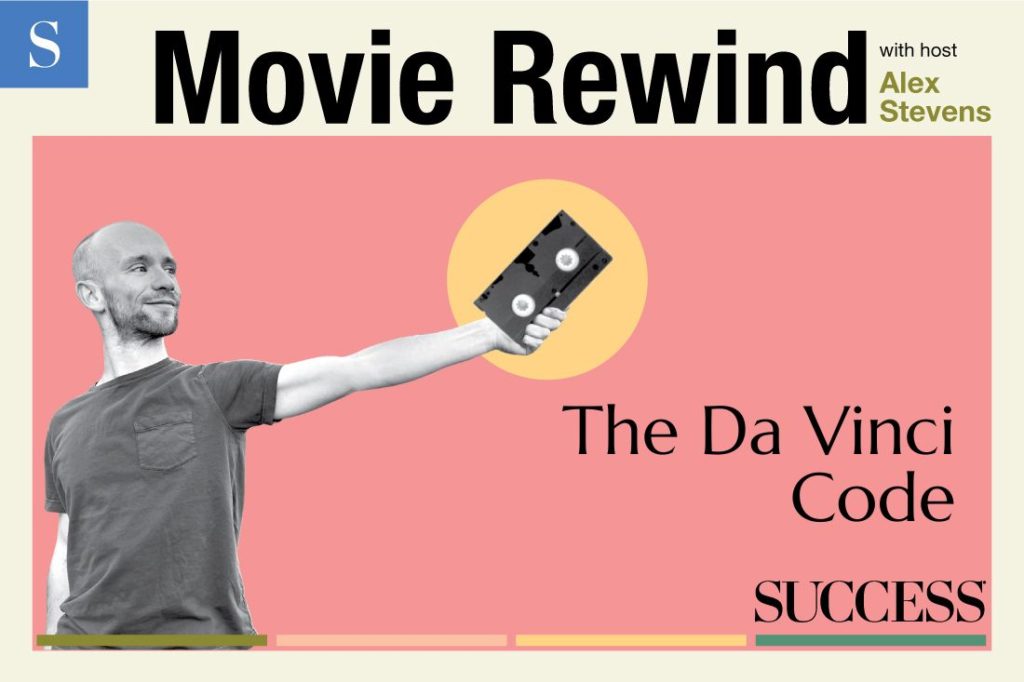The Romans adopted Christianity as the state religion in 313 A.D., and just under 1,700 years later, The Da Vinci Code hit theaters. A lot happened between those two temporal waypoints, but both events had some big effects on the Western intellectual tradition that has emerged since the time of Jesus Christ.
Of course, we’re not a history podcast. We’re not even a book podcast—otherwise we’d talk about the book The Da Vinci Code that came out in 2003. Alas, we’re a motivational film criticism podcast, so we’re talking about the Tom Hanks-starring box office buster that came out in 2006.
And there’s a lot to talk about, so buckle up. Welcome back to SUCCESS Movie Rewind, the only podcast still talking about The Da Vinci Code in 2022. Let’s see what empowering, enlightening, enriching personal development lessons we can squeeze out of this film.
See beyond the symbols.
It’s kind of hard to imagine such a person in real life, but if you’re someone who just really dislikes symbols and symbolism, avoid this movie at all costs. Symbols are basically the plot. If you are that person, however, you might like our first SUCCESS Movie Memento™ for this week, which is this: See beyond the symbols.
Now for some context. In The Da Vinci Code, we have America’s dad (Tom Hanks) as Professor Robert Langdon, this cool-guy professor who talks about mind-blowing stuff fairly regularly. He’s the main character, and we see him deliver a lesson to some students in which he presents some symbols and then debunks the students’ interpretations of them. It isn’t a Ku Klux Klan robe—it’s what Spanish priests wear. It’s not the devil’s pitchfork—it’s Poseidon’s trident. And so on.
Langdon gives us this window to understanding the power of symbols in the film, showing us that the symbols mean different things to different people. Then, we see this group within the Catholic church called Opus Dei. They’re on a quest to extinguish Jesus’ bloodline, and if your response was “Jesus’ bloodline, you say?” then you need to just watch the movie. But to the folks in the film version of Opus Dei, the symbols become so important that they’re willing to kill innocent people.
And that’s why I say we need to see beyond the symbols. Obviously (I hope), you’re not in some murderous cult group, but you very likely have developed some symbols in your quest to build your business, advance your career or better yourself in some way. You might think of certain people not as people but as what they mean to your particular quest.
Let’s try to avoid that. Everyone is as important in their own story as you are in yours, and we all contain the potential to change the world and the lives of those around us.
Free association will free your mind.
Langdon does this thing where he just starts saying words that connect the concept he started with to the concept he’s getting to, and he doesn’t know where he’s going to end up. It’s almost kind of funny in the movie, but I can’t criticize it because it’s a well-known method of psychoanalysis and brainstorming called free association.
It’s also our second SUCCESS Movie Memento™ of the week: Free association will free your mind.
I’ve said this before and I really believe it: Free association can be really important in the creative process. When you’re about to do something important, if you’ve prepared the right way, you need to let yourself speak, perform or act. What comes out may surprise you because when you really let free association take hold, you’re letting your higher self emerge as your ego falls by the wayside.
So, when it’s time to hit record, step up to the mic, give your presentation, get on that Zoom call, whatever, you can’t be afraid to speak. And if you did it right, you’re as prepared as you need to be.
The real Holy Grail is the quest along the way.
Confession time: This SUCCESS Movie Memento™ is based on a popular meme format—the one where you say that “The [SUBJECT] was really the [OTHER SUBJECT] we made/learned/met/etc. along the way.” So, you might have something like, “The real treasure was the friends we made along the way,” but in our case, it’s this: The real Holy Grail is the quest along the way.
A meme-based takeaway may be a first in SUCCESS Movie Rewind history, but I don’t mean to make light of it. The Holy Grail is an important religious symbol, and the central plot of the film involves a search for it.
But since we’ve been talking about symbols, let’s take a moment to consider the Holy Grail as a symbol for the big achievement you’re pushing toward. You’re going to work a long time to reach that point, and then what? That may be the end or near the end of your journey. Does everything else before that cease to matter?
Absolutely not. I posit that the real Holy Grail is not what you’re seeking but how you’re seeking it. It’s what you believe and do to get to the end point you’ve identified as your goal. Figuring out what’s in your heart and what you truly believe is always going to be what’s most important. I’ll stop there, Rewinders. I hope the next week brings you closer to your Holy Grail, and either way, I’ll be back here next week with more movie wisdom. Thanks for your support in this aspect of my quest. See you next week.











